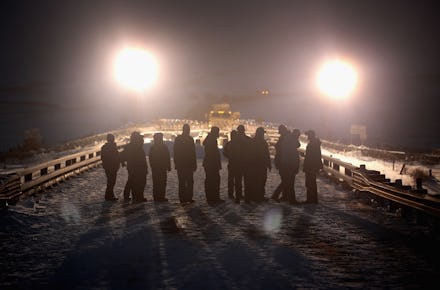Standing Rock was infiltrated by a private contractor who compared protesters to warring jihadis

They are, it is said, extremists — radicals waging an ideological war, driven by an extreme religiosity — and only by using the tools and tactics developed in Iraq and Afghanistan can we prevent them from exporting their insurgency.
This is not a description of a terror cell or a group of locally grown fascists; it is how a security firm engaging in surveillance at Standing Rock described the protestors (many of whom were Native American) there.
New documents obtained by the Intercept show TigerSwan, the private security firm hired by the company behind the Dakota Access Pipeline, infiltrated and surveilled the Standing Rock resistance movement using counterinsurgency tactics learned while waging global war on terrorism.
But the Standing Rock water protecters are just the latest in a long line of peaceful, left-leaning movements to be treated as threats to homeland security and dispersed using the tools of war.
Collaborating with police departments in five states, TigerSwan described the Standing Rock resistance as "an ideologically driven insurgency with a strong religious component" that follows a "jihadist insurgency model."
"While we can expect to see the continued spread of the anti-DAPL diaspora ... aggressive intelligence preparation of the battlefield and active coordination between intelligence and security elements are now a proven method of defeating pipeline insurgencies," TigerSwan wrote in its reports this past February.
TigerSwan didn't just keep an eye out for potential violence escalation: They took regular aerial surveillance, intercepted radio communications and infiltrated activist circles.
Still, the collaboration between defense contractors and federal law enforcement didn't start or end at Standing Rock. The history of using military tactics to surveil and dismantle peaceful movements is decades old, and most often targets the left.
In order to execute a violent crackdown to break apart the encampments of Occupy Wall Street, for instance, the FBI and the Department of Homeland Security started a council that included the security forces of investment banks, who helped build dossiers on peaceful protesters and plan raids months in advance.
When dealing with Black Lives Matter, Homeland Security and local police forces turned the tools of organization against peaceful protesters, using Twitter activity to build maps of conflict zones and keep an eye on organizers.
And some conservative-leaning citizens have taken on anti-left surveillance: Alt-right trolls on 4chan threads and Reddit forums have built dossiers on hundreds of potential anti-fascist activists, putting together photos and other clues in order to expose, harass or report protestors to the authorities. In response, leftists have ramped up their personal security, learning new digital communication tools and moving conversations about organizing over to encrypted communication apps like Signal, trying to make surveillance and infiltration difficult for law enforcement and trolls alike.
But even as leftist activists are in an arms race to protect themselves from infiltration, the radical right is flourishing out in the open — and without, apparently, the same level of surveillance from the state.
In fact, in 2009, Homeland Security Secretary Janet Napolitano was forced to apologize for a report that said veterans groups might be a ripe ground for right-wing extremist recruiting. The report, which was withdrawn and loudly decried by veterans groups, said that this trend could be exacerbated by the election of a black president and growing xenophobia.
It was prophetic — over the next year, the Oath Keepers would become one of the largest factions in the militia movement. But, for the feds, these are not apparently the movements worthy of scrutiny.
Meanwhile, the Standing Rock resistance — on the ground, at least — is mostly routed, and environmental activists have largely moved on to other fights. The pipeline is expected to begin moving oil on June 1.
All that's left now is to see the first oil spills begin, and to put the protesters on trial.